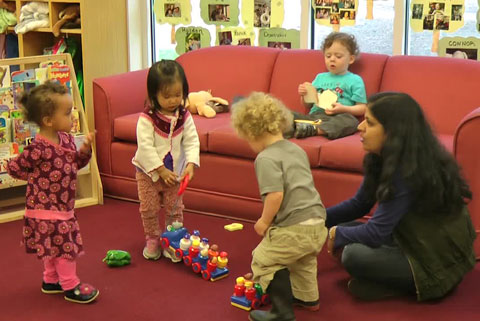About this video
This video takes place in a toddler room of a university laboratory child care and preschool. Sadie (26 months) pulls two trains across the carpet and sits down on the teacher’s lap. Sadie and the teacher are talking about the two trains while Daniel watches. Daniel reaches down to take the handle of one of the trains, to which Sadie objects. The teacher then asks Sadie to give one of her two trains to Daniel.
Video
Transcript
The teacher is sitting on the floor and talking to two children on the couch. Sadie pulls two trains over and sits on the teacher’s lap.
Teacher: Here Sadie. Oh, look at that. Two trains! Look at all those people. Who is driving the … train?
Sadie: Elephant!
Teacher: Elephant is driving the train. In this one.
Daniel leans down to pull the train’s handle.
Sadie: Mine!
Offscreen: Who do you have?
Teacher: You want the train? It’s okay. You have two trains. Why don’t you give one to Daniel?
Sadie hands one of the trains to Daniel.
Teacher: Thank you for sharing. Give one to Daniel.
Daniel and Sadie each now have a train.
Illinois Early Learning Guidelines for Children Birth to Age Three and strategies that caregivers used
Self-Regulation: Foundation of Development
Emotional Regulation
Children demonstrate the emerging ability to identify and manage the expression of emotion in accordance with social and cultural contexts.
- Strategies for interaction (21-36 months): Validate the child’s feelings and let them know it is okay to feel the emotions they are experiencing
- Action: After Daniel tried to take a train, the teacher told Sadie that it was okay because she had two trains and could share with him.
Developmental Domain 1: Social & Emotional Development
Emotional Expression
Children demonstrate an awareness of and the ability to identify and express emotions.
- Strategies for interaction (21-36 months): Recognize that the child may need some assistance in expressing feelings
- Action: The teacher recognized that Sadie may need some assistance in expressing feelings and let her know that it was okay to share one of the trains with Daniel since she had two.
Developmental Domain 1: Social & Emotional Development
Relationship with Peers
Children demonstrate the desire and develop the ability to engage and interact with other children.
- Strategies for interaction (21-36 months):
- Provide toys that can be played with by two or more children at a time
- Provide activities that encourage sharing, while limiting the risk for frustration
- Action: The teacher provided more than one train so they can be shared by two or more children at a time, and the teacher encouraged them to do so.
Developmental Domain 3: Language Development, Communication, & Literacy
Expressive Communication
Children demonstrate the ability to understand and convey thoughts through both nonverbal and verbal expression.
- Strategies for interaction (21-36 months): Speak in simple sentences when communicating with the child
- Action: The teacher spoke in simple sentences when telling Sadie that it was okay to let Daniel use one of the trains since she had two.
Approaches to Learning
Problem Solving
Children attempt a variety of strategies to accomplish tasks, overcome obstacles, and find solutions to tasks, questions, and challenges.
- Strategies for interaction (21-36 months): Be available for the child and recognize when he or she needs guidance
- Action: The teacher was available for Sadie and Daniel and recognized that Sadie did not want to share, but then reconsidered after the teacher told her it was okay.


